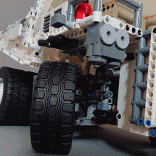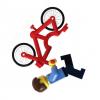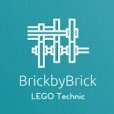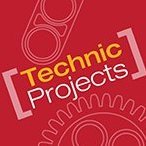Search the Community
Showing results for tags 'pneumatic'.
Found 155 results
-

[MOC] Volvo LM 841 Front Loader
Jundis posted a topic in LEGO Technic, Mindstorms, Model Team and Scale Modeling
Hi guys and gals, today I'd like to present my MOC based on an old Volvo LM 841 Front Loader: The main goal was to achieve the mechanism used for the bucket with the oddly placed hydraulic/pneumatic cylinder. Due to stability, I used a 3x11 panel and could get the right mounting point for the small cylinders. Also, the narrow 1x11 cylinders I intended to use for the lift weren't strong enough, so I went with the stronger 2x7. This sadly led to a lower lift height. Pneumatic pump is placed in the cabin like in the 8455, while I rather place a fake 6 cylinder engine in the hood. In this size I went with front driven engine, although the real thing is 4WD. Main functions are: - steering with pendular rear axle - lift of the bucket - tilt of the bucket - fake inline 6 driven by front wheels I just love older equipment, which gives more a feel of old Lege technic also :-) -

[MOC] MAN Lion's City articulated low floor bus
Fosapifi posted a topic in LEGO Technic, Mindstorms, Model Team and Scale Modeling
It has been quite a while since I last posted here. But this Project seems to be worth sharing with you. At 9869 parts and 8.4 kg, it is by far our largest project. The goal was to include motorized driving and pneumatic suspension without using any of the interior space. So yes, it has a real low floor going through the whole length. RC-functions: - The third axle is driven using 4 PF L motors, 2 CaDA metal u-joints and the new LEGO heavy duty diff. We destroyed many parts while prototyping. We tried to include a 2-speed gearbox, off-center diff, no diff at all and single wheel drive. The current setup is the only one which was working in the end. - The first axle is steered by a PF servo, located under the driver seat. - The bus has two separate pneumatic systems. One for the suspension and one for the doors. Both have their own manometer and pump, actuated by a PF L motor. The suspension system has 2 air tanks, the door system has 1. - The left suspension can be raised manually with a switch in the driver's cabin. The right side is operated by a PF servo. We included a check valve to enable slow kneeling. The switches are connected in such a way that the pressure in the air tanks is always kept while kneeling. The suspension system uses 22 small pneumatic cylinders and 10 shock absorbers. - The doors are also operated by a PF servo. The second and third door can be disabled separately from the driver's cabin. The system has a total of 6 cylinders. - We managed to hide a micro motor under a seat behind the first axle. It is used to unfold the wheelchair ramp. We used a red 9244a u-joint to hide the mechanism in the side wall. - A total of 8 LED pairs is used for the lighting. The functions are controlled by 4 s-bricks. For power supply we use one 84599 rechargeable battery box and one buwizz brick. The bus uses 14 extension wires and 14+ meters of hose. One of the hardest challenges was to prevent the bus from bending. The floor is only 2 studs thick and has weak spots over each axle. The roof is responsible for the rigidity while only being connected to the lower section with a few liftarms. It also houses most of the technic. There are several tight spots where every millimeter is used for hoses and wires. Problems: The suspension system is very unreliable. Many of the small cylinders leak if they are unevenly loaded. We had to buy more of them than we need and still the kneeling does not work every time. The front and rear section are only connected with one turntable in the roof and one pin in the floor which makes it hard to pick the bus up. The building time was 3 years with many breaks. We wanted to replicate the exact version of the bus which is used in Munich. Unfortunately all articulated buses with 3 doors were retired during the building process. It is very disappointing that we could not build it in blue because LEGO thinks it is a good idea to use 5 different shades of blue than releasing all basic parts in one color. As usual we published free building instructions at rebrickable: https://rebrickable.com/mocs/MOC-126294/Fosapifi/man-lions-city-g-articulated-low-floor-bus/#parts If you want to watch the instructions for entertainment, we also have a video version: https://www.youtube.com/watch?v=GiKy4xixxmo You can find a very ugly pneumatic plan in the instructions. The bellows are a further developed version of Sariel's design: https://www.youtube.com/watch?v=I8_YJK_WNpY Also big shout out to the incredible CapaCity L by krolli: https://www.eurobricks.com/forum/index.php?/forums/topic/167663-articulated-bus-like-capacityl/ -

42144 Grand Prix Air-Truck - alternate build
Timorzelorzworz posted a topic in LEGO Technic, Mindstorms, Model Team and Scale Modeling
Hi Boys and Girls, I am happy to share my newest creation. Follow link for instructions More details here 3D-Play here This Grand Prix Air-Truck is an alternate build for official model 42144 Material Handler. All 805 required parts to build comes with this set and there is no need for other parts or other sets to build this Truck. In order to give this model a complete look, 7 spare parts are required that are all available with set 42144. Inspired by a real Race Truck, this model features: manual steering with knob openable doors on both sides tiltable cabin with lock V6 engine with moving pistons Pneumatic functions high-adjustable rear-axle with air air-suspension detailed design 32cm x 15cm x 15cm (38cm with open cab) In scale, this alternate build fits all mid-sized Trucks from the past years with the same tires and rims. Impressions Air-Suspension and how it works This model comes with Pneumatics and an adjustable rear axle that is connected to the V6-engine, where air-filled cylinders acts like shock absorbers. The lower the air-pressure is, the smoother the suspension works. The harder the air-pressure is, the harder the shock absorbtion works. The rear can be adjusted from low with no suspension to the highest point with full air-suspension. Instructions are very clear and understandable on how to connect Pneumatic-parts and tubes. Instructions Premium PDF instructions for this 42144 alternate build comes with 181 pages of high quality images and building steps to ensure a long and satisfying building experience. Following are example pages to show the quality of instructions: We will Truck you. This Grand Prix Air-Truck alternate build uses almost all parts from the given set 42144. Have fun with it.-
- 42144
- alternate build
-
(and 4 more)
Tagged with:
-

[MOC] Bobcat Toolcat 5600
weavil posted a topic in LEGO Technic, Mindstorms, Model Team and Scale Modeling
I'm back with another ambitious project. The Bobcat Toolcat 5600. I can't remember where I first seen it, but thought it was cool and (to me) practical. So I then searched online and came across System and minifig scale builds. Then I found this build thread on here of a larger PF version. So I set off getting info, working on a plan, and laying down ideas. I wanted to give this build manual functions with pneumatics. I had a hard time getting the scale of the vehicle dialed in as I had some trouble finding good side pics and the right Lego tire. However, as I kept gathering details, I found what the tire size it has and which Lego wheel was closest to a usable scale. I find that a scale of 1:8.4 worked perfect with the 81.6 x 38 (it was just a little wide, but worked fine). Here is the item its self: The real Toolcat has many variations. Solid axles or independent, closed lift arm or split tubes, turbo or not, and so on. The one I used has solid axles, closed lift arm, and an easier engine setup. My build has many functions that tested my mental limits: All-Wheel-Drive All-Wheel Steering Working Suspension Pneumatic Functions Dumping Bed and Tail Gate Front Pneumatic Accessory Hookup On to the building! Starting with the frame for all the bits and bobs to attach to. Trying to find an image of the chassis proved to be pointless, so I did my best guess from regular pictures. This is the first try. It rebuilt it about four times. Engine placement for now. The version of the real one has a four cylinder engine that powers a hydraulic pump. The real one also has hydraulic drive, but that's not for Lego yet. Forgot to snap some pics of the progress, but this is the second build of the chassis/frame. I had to reduce the engine to 3 cylinders to allow for a drive system. The steering changed after this build as I needed to redo the way it was fixed to the frame. The design of the axle. The frame from the bottom. (It changes some in the final) The first layout of the cab... It was the second hardest part... Laying the pneumatic tubes was way to hard having mostly short pieces. One of the early drafts of the cab. I was at a crossroads by not having enough #3 connectors, running out of white parts, not having enough black 5L/7L beams or 3x7 panels, and no tan technic parts. So I redesigned the door and found that the ribbed hosed worked great. That's the bulk of the build process, the rest was fine tweaks, subtle add-ons, and fighting with Pneumatic hoses. So here is the final product: There are plenty more pictures here! Thank you for your time. -
profile.thumb.jpg.c5cab62825264b0a856bb04fab3d86dc.jpg)
[MOC] Pneumatic Cherry Picker - 42128 alternate + instructions
BrickRandom posted a topic in LEGO Technic, Mindstorms, Model Team and Scale Modeling
Inspired by LEGO 8292 Cherry Picker, I've created a pneumatic rendition of that model as an alternate build of LEGO 42128 Heavy Duty Tow Truck. Pneumatic Cherry Picker by Brick Random, on Flickr My Pneumatic Cherry Picker has the following functions: steering (turn the knob on top of the cab) raise arm (pneumatic) extend/retract arm (pneumatic) turn arm (lift and turn the knob on top of the cab) open doors (manual) 4 cylinder engine driven by the four rear wheels A video demonstrating the functions: The basic shape of the original model is still visible in the final build of the Pneumatic Cherry Picker. However, the internal structure is almost entirely new, as a result of changing from mechanical to pneumatic operation of the arm, adding the engine (with two differentials for the four rear wheels) and the availability of parts in 42128. Instructions The model consists of 900 parts (all from 42128 Heavy Duty Tow Truck). Building instructions (a 215 step PDF document) are available on Rebrickable: https://reb.li/m/123565 More pictures are available on Flickr: Pneumatic Cherry Picker by Brick Random- 2 replies
-
- 42128
- cherry picker
-
(and 3 more)
Tagged with:
-

Three Wheeled Loader Idea
weavil posted a topic in LEGO Technic, Mindstorms, Model Team and Scale Modeling
I present to you the "3" wheeled loader. The back wheels act as one, It was an idea spawned from a mix of the Bell 3 wheeled sugarcane loader and BM-VOLVO LM loader, so a three wheeled loader. Took me a little longer to build then I care to admit, because of the lift arms and the not having the hoses kink or bind. It's nothing special as far as build goes. It might look better if I had a little smaller bucket. The truck used for the demonstration is a slightly modified version of grego18's on Rebrickable. More pictures HERE.- 14 replies
-
- wheel loader
- loader
-
(and 1 more)
Tagged with:
-
[MOC] Lego DRG V3201 - Diesel/Pneumatic Locomotive - in 12v style
Paperinik77pk posted a topic in LEGO Train Tech
Hi all, always starting from this inspiring discussion... ... @Reker1000000 introduced me to a very particular locomotive: "DB V3201 seems like it would be an interesting starting point for a locomotive to model in 12v style with the red motor..." The locomotive we're speaking about is the DRG V3201, one of the first experiments to upgrade from steam to Diesel engines. In this case, Diesel motors were available , but problem was related to transmitting their power to the wheels. Gears were too weak, Hydraulic transimission was still in development...so the idea was to replace steam with compressed air, therefore maintaining the "old" transmission system (including distribution) used by steamers. In short, it worked this way: DIESEL ENGINE --> COMPRESSOR --> RESERVOIR -->CYLINDERS --> COUPLING RODS --> WHEELS More or less what is seen in some Pneumatic locomotives made in Lego (great stuff!) with electric motors. Well, seems great, but there were many problems related to the heating of compressed air, its cooling (!) and cylinders lubrication - all for maintaining its efficiency. Here's an interesting link! http://www.douglas-self.com/MUSEUM/LOCOLOCO/diesair/diesair.htm All in all - a very complex hybrid system, with many gaps to be solved with engineering "patches". But it's a cool locomotive and making it in 12v style could really be a challenging task. First of all, it's the most asymmetric thing I've ever seen , second - it's a very tormented design - which cannot be captured fully in 12v style, due to lack of parts at the time. It's however a very peculiar locomotive (depicted also in a postal stamp!!!) and it's worth to be tried. Here it is, just out of the shed , helped by a small V60. In reality, this event could not happen, since the V3201 was scrapped many years before the launch of the little shunter, but since we can do whatever we like with our fantasy, I was more optimistic and imagined a restored V3201 ready for some hystorical train! The V3201 is based on the chassis of a BR78, which - luckily - is one of the 12v locomotives I've already tried to create. Therefore, chassis was already prepared and only needed to be adapted to the longer body. This big beast has a quite boxy body, which seems to be made soldering together some parts of cabins, cut from steam locomotives. The central part of the body is sticking a bit out from the overall shape, and this is due to the big submarine diesel and air reservoirs. The main charachteristics are the two big gray radiators, the small windows on the corridor side, and those big stairs. Stairs were a nice thing to replicate, even if these are not the same as in the prototype. I did not use the big train doors, since these did not allow me to recreate the stairs and handrails. In the real thing, the stairs go over the cylinders, so using the 12v standard ones was quite a mess. I replicated them with normal parts. and this was not a problem. I had however to "cut" the stairs in half, the upper one being fixed to the body, while the lower one being part of the bogie (and turning accordingly). With the 12v motor, this design needed to be somehow adapted. On a real 12v motor, the central hole can accept an half Technic pin. Using a normal Techic brick some plates and tiles solved the problem. The ladder is kept in place by the pin and "slides" together with the motor. Between the radiator and the cabin there's a small, virtually transparent door since it's made of a panel full of small holes. The body in reality should be 4-wide in that point. I tried fences, door fences, everything did not fit and SNOTting was quite impossible (for me at least), given the limited parts available. Even Marklin's model is solid in that point, so I concentrated more on having at least a grille pattern. Using the ladder part was not so nice, it was just confusing. I therefore tried the just seen @zephyr1934 technique (thanks to you and Katy!), to have some visible horizontal lines. I used 3794b parts (jumper) . It works also with normal plates, but this is way better. Doors features a possible, even if not used at the time, SNOT for the door hadle, using headlamps bricks. Here's a shot from above, showing the 7-wide central part of the locomotive. As you can see I played a lot with the jumpers parts. And here's the "blind side" of the locomotive there's not so much to say ,being pretty smooth! Apart big red wheels and red motor, 2x1x2 and 1x1x2 black windows are there, just to remember there's some 7730s and 7750s blood inside the veins of this "thing". Here is visible the big radiator... ...and here is visible the smaller one. Looking better at the central headlight you can see some "white stuff" between the bricks - it's the classic 12v light brick with the addition of a small diode. This old trick allows the headlight to be lighten up according to locomotive's direction. Radiator is made by 1x1 plates, trying to replicate the "pattern" of the real thing. I put here red lights in 7777 style, even if these should be white, according to prototype. A brief mention to the Shed - it's an old MOD - I do not sincerely remember if I already presented it here in Eurobricks. It's a 7777 build, converted to a more shed-looking thing. Since I like to replicate dioramas in 12v style, this could be a nice addition to the overall scene. I hope you like it! Thanks again to @Reker1000000 for his inspirational idea! Ciao, Davide -

Pretty compact inline 3 LPE
Pnumetac posted a topic in LEGO Technic, Mindstorms, Model Team and Scale Modeling
Hi, I designed a pretty compact inline 3 pneumatic engine: If someone‘s interested, I‘ll consider making instructions. Pascal Here are some pictures: https://share.icloud.com/photos/0nS1bu-NzDFND9IuROoaiSaQw https://bricksafe.com/pages/Paacsl/compact-inline-3-lpe -

How do you connect an air compressor to a LEGO pneumatic engine?
LegoBuilder919 posted a topic in LEGO Technic, Mindstorms, Model Team and Scale Modeling
Hello everybody! I have been recently thinking about building the V8 WK3 pneumatic engine, from Greek Gecko Workshops. On their page, it says that to get max RPM you need 116 psi, and you need to be able to hook the engine up to an air compressor. Does anybody know how to do this? I have not been able to find any answers. Thanks, LegoBuilder919 -
Hey guys, During a chat I was pointed to the Steinwinter Supercargo 2040. I was fascinated by the look and decided to build it. It was designed by the german engineer Manfred Steinwinter. During my research, I found out that he build only one prototype, but planned many more versions. I liked the three-axled version and so started with a rough sketch to get an idea of the proportions: While I was searching for images of that truck, I also contacted the current IP owner and asked for blueprints. Fortunately he liked my project and he send me some. Since then this truck went through many iteration of improvements and design changes. In the end I decided to use Powered Up to control it. This is the current state: These are planned/implemented features and specifications: Current weight: 3kg Length: 86 studs Height: 14 studs Width: 27 studs Power supply: 4x Technic hub Driving: 4x C+ XL motor, each motor is connected to one hub to spread the load (3,528:1, theoretically 0,74 km/h @7,5V @124Ncm) Steering: 1x C+ L motor, two steered axles with Ackerman geometry Compressor: 1x C+ L motor, 4 pumps 3 RC valves: 3x C+ L motor, 3x newest valve one for each the rear axle, front/middle left wheel, front/middle right wheel Angle sensor for suspension on front and middle axle: 2x C+ XL and 2x Boost Medium motors OR 2x C+ XL Angle sensor for rear axle: 1x motor (not implemented yet) Air/pneumatic suspension on all axles controlled by Powered Up double wishbone suspension on fron and middle axle Each front/middle wheel on the left and right side are one unit. That means if the front wheel is pushed up the middle wheel is pushed down. That way the weight is equally distributed on the wheels live rear axle When I decided to use Powered Up I thought about controlling the ride height somehow with Powered Up. To do that I needed something to read the position of the double wish bone arms and the rear axle. Since several motors in the C+/Powered Up eco system can report their position, tried to use them to read the angle of the suspension arm. I successfully implemented that on the front and middle axle. For the rear axle I haven't found a good solution yet, because that axle can move on two axis. While I'm waiting for some additional parts, I'm working on the solution for the rear axle. As for the code, I already made a proof of concept. I created a test setup and wrote some code, which reads the angle of a suspension arm and adjusts it to the desired value. for the finished MOC a can think of something like a parking height, highway ride height and more or less off-road height. Once the chassis is finished the and the Powered Up is working I'll start working on body. Feel free to leave comments, critique and suggestions.
- 13 replies
-

Eurobricker’s Share your Trailers!!!
CrazyKreations posted a topic in LEGO Technic, Mindstorms, Model Team and Scale Modeling
Hey everyone, you must check out the share your trucks forum for many talented eurobricker’s inspirational truck designs! But this topic is for those who have made their own custom trailers and mods that they are proud of! I will start first Here is my trailer for my custom Semitruck. I am currently designing a nice off-road capable caravan which I hope some of you would like to see, I am almost finished and I will post it here when I am done. -

Weak Pneumatics 42043
Rebel_Lego posted a topic in LEGO Technic, Mindstorms, Model Team and Scale Modeling
Hi, I stored my MB Arocs for about half a year. I rebuilt the B model into the A model, but the pneumatics just won’t work. I looked for any kinks in the hoses, tried the pump, tried the cilinders with nothing attached, and it all works fine. The cilinders are also re-oiled. If I attach the first section of the crane, it works fine. However, if I put the second section on, the cilinder can’t lift the crane. The problem lies just with the first cilinder. I even swapped the cilinder for the second section with the cilinder for the first section, but both cilinders seam too weak for the weight of the crane. I’m not really experienced or anything with this kind of stuff, I just build and play, and if I make MOCs its certainly not with pneumatics. I read several forums but all the solutions given there were the things I already tried. So, has anyone an idea what this might be? Maybe because I stored my Arocs the cilinders caught too much dust? PS. I also thought about adding an air tank, but I don’t know if that solves the problem? -
Hello everyone: I am glad to share this project, the mining excavator, based on Cat 6090. Phisycal Configuration: The Lego Cat6090 is a motorized digger on tracked wheels, 2 XL motors provided enough torque. On the track frame is placed the main structure, and a heavy duty turntable allows good rotations, without fricctions. The turntable is rotated by means of 1 XL motor. The main structure contains: the XL motor for turntable, the air compressor, 4 servos for pneumatic valves and the controller. The design is ultra compact in order to meet the requierement of size/scale. The tracked whell is ultra rigid structure, designed to resist extreme load. The air compressor has 4 XL motor and 2 pneumatic pumps, in order to provide a constant air flow and high pressure, both pumps are de-phased 180° in order to reduce vibrations. 4 PF-servos open/close 2 way air valves, to command all pneumatic actuators. The boom has 2 large pneumatic actuator. Due to heavy height of the boom, 4 spring supply extra force during the elevation. 2 large pneumatics actuators push/pull the arm, those actuators are placed below the arm. 2 large penumatics actuators dedicate to rotate the bucket. 1 medium pneumatic actuator, open/close the bucket. Electrical configuration: Three 18650 batteries provide an average of 11.1 V, the compressor are suplied with 11.1 V, and the servos, lights and turntable motor are suplied with 9V. A BMS (Battery Managment System) manages the charge and the discharge durgin the operation. The tracked frame is steering by the use of 11.1 V, and as well is manage by the use of a BMS. On Board System (OBS): The name given to the controller. There are two systems, one for the main structure, and the secund is used to move the tracked well. The main controller, is a server TCP/IP protocol. The controller has a ESP8266 microcontroller with a TCP/IP stack, this controller is able to be programmed in arduino languaje (also micropython) - Teh ESP8266 is used as a sever, Motor driver: used to control the compressor The 4 PF servos are controlled by means of digital outputs, and the lights. ld293d, this is a H-bridge used to control the turntable motor. The second controller, is a ESP8266 as a client, and controls the speed of the tracks. Also, it has a BMS in order to regulates the charges/discharge of the batteries Accessories: 1) Josyticks: Two joysticks, with 4 dof (degrees of freedom) each of one plus a on/off button, are connected to the server module. 2) App: An application developmented under Android studio is used to visualizate the air pressure and electrical current, this app is WIP (work in progress). Conectivity: The comunication used is socket TCP/IP- Main features: maximun pressure reached: 52 psi (358 Kpa) Voltage bus: 11.1 V Compressor electrical consuption: 23 W Weight: 6 kg Length: 30 cm width: 20 cm height: 30 cm Here some pictures, during the construction and commissioning Note: my apologies for my primitive english
-
Wheel Loader 1:17 scale inspred by volvo
functionalTechnic posted a topic in LEGO Technic, Mindstorms, Model Team and Scale Modeling
Hi everyone After one year I finished another MOC. Here I present my wheel loader inspired by Volvo wheel loader L120H with technic chassis and creator style body. The model is controlled by two Sbricks an powered by one small PF battery boy. The boom and the bucket are controlled with pneuamtic cylinders coupled to a geared servo motor with the newest pneumatic valves. Like this it is possible to control "heavy" loads precisely. Furthermore, the model has an auto compressor which is controlled via the BrickController2 app, where it is possible to add one port of the Sbrick (here the compressor) to two independent other functions (here the two servo motors with the valves). Like this the pump always switches on as soon as one of the pneumatic function is selected. But check the functionality in the following video: Instruction is available on rebrickable: https://rebrickable.com/mocs/MOC-64106/FT-creations/wheel-loader-inspired-by-volvo/#details- 31 replies
-
- volvo
- wheel loader
-
(and 3 more)
Tagged with:
-

42080 pneumatic pump
trinitechnic posted a topic in LEGO Technic, Mindstorms, Model Team and Scale Modeling
Hello all, Further to this post: Can anyone confirm if 42080 contains the revised pump variant, with the square, reinforced base? I know that the updated part was implemented in 2018, but I'm not sure if it made it into 42080. Thank you. -

[MOC] Thirdwigg Farm Machines (New John Deere Gator)
Thirdwigg posted a topic in LEGO Technic, Mindstorms, Model Team and Scale Modeling
All Thirdwigg Farm Instructions Tractor Instructions Forestry Trailer Instructions Dump Trailer Instructions Disk Harrow Instructions Mechanical Seeder Instructions Power Harrow Instructions Furrow Instructions Snow Plow Instructions Mower Instructions _______________________________________________________________________________________________________ A lot of WIPs going on here is Thirdwiggville, so while the Unimog and SRT are still in progress, let's add another tractor. The tractor came together in 10 days, which is pretty quick for me. Not sure about the mirrors or the air intake, but the rest is pretty final. Now on to the trailers. -

[MOC] Pneumatic Grab Machine
paave posted a topic in LEGO Technic, Mindstorms, Model Team and Scale Modeling
Pneumatic Grab Machine is something like futuristic excavator with grab function - Pneumatic cylinders - Manual pump control - 2 M-Motors for drive - PF Battery Box - IR receiver -

How do I open the first version Pneumatic Cylinder?
Reinder posted a topic in LEGO Technic, Mindstorms, Model Team and Scale Modeling
Hi, Bought a nice lot yesterday with some interesting technic parts. My five year old started building right away and was very interested in the pneumatic cylinders that were in there. But as it goes with five year olds, he was also a little too excited with pumping away the cylinder and that resulted in the seperation of the piston and the cylinder. It does not look to be broken off, but I'm not sure if it's fixable or not. I want to try to repare it, but I don't know how to open it. I've seen some posts about opening the cylinder but they are always the later versions. This is the red one which was only in one set: 8040 building set. (part number 4688c01) Does anyone have some tips about opening it and if it's reparable or not? Thanks! -

[MOC] Hydraulic slewing crane T157/1
jrx posted a topic in LEGO Technic, Mindstorms, Model Team and Scale Modeling
Hey guys, I want to introduce my latest MOC: The hydraulic slewing crane “T 157/1” – a crane (or rather an excavator or “loader”) that was developed and built in the former GDR. Actually, the machine is quite ugly, but somehow it fascinated me and I had to build it in LEGO® Technic. That's the real excavator (and it's really ugly …): The excavator is completely mechanical or pneumatic and of course fully functional. Therefore it drives, steers and excavates. The challenges during construction were on the one hand the really limited space (of course I wanted to accommodate all functions) and on the other hand the unusual construction of the front axle. The latter also cost me a few evenings and many tests. Also for the tires at the front I had to come up with something. LEGO® doesn't have suitable wheels in its range. The solution: I mounted the balloon tyres 68.8×40 on the Technic 43.2×26 rim, which was actually too small. And lo and behold, it worked and looks great. Also the construction was very fiddly due to the limited space. So the pneumatic pump had to find place underneath the excavator as well as the turning wheel for the rotating construction of the excavator. But in the end it fitted. Thanks to the new pneumatic valves, I was able to build real joysticks. Therefore: Each of the sticks in the "cockpit" really controls the functions of the model. And even if it was tight, there was enough room for a few details like V-belt, tank and exhaust. Finally my excavator in action: -
Let me introduce my latest build: Truck with concrete pump Introduction I got the inspiration for this kind of truck very long ago from this spectacular build from Waler: http://www.brickshelf.com/cgi-bin/gallery.cgi?f=558238 . It was one of the first builds I saw when my dark age ended and I kept returning to it ever since. I knew I had to build my own when the time is right. I tried it once already (not published) in smaller scale 3 years ago but I wasn't skilled enough, the scale was wrong and I lacked the parts. I hope it is better this time. I also knew that I want to build it with very different features, Waller's truck if fully RC and I have found out that I prefer single motor and gearbox and steering and drive. IMGP5397 Features & build The list of features I wanted to implement were clear from the begining - full suspension, one motor for 6 functions, 3-section pneumatic arm, gearbox with two way switches and modular build. I wanted similar build/experience like Arocs so I have borrowed few features from it, most important is the way how the 3 modules (front axles with cabin and "crane", central gearbox, rear axles) are connected together. So I took the size of the gear box and its attachment points from Arocs and made my own one within the limits. Later I had to drop the 6th output that was supposed to drive some sort of lever ("pump") inside of the hopper because of complexity. The first iteration of the gearbox was quite fine, but it struggled when the long outriggers were hood on it because I have used clutch gear before the whole gearbox. That was major flaw so I had rebuild it again (almost) from scratch and even managed to add second penumatic pump to it. Each function is proteced either by white clutch gear, rubber band or LA clutch. The gearbox is powered by one L-motor which is powerfull enough to drive everything. Concrete pump gearbox There are two switches on either side between the axles, on right there is switch for spreading outriggers and extending front ones, on left there is switch for lowering them and for pneumatic pump. Switch for arm rotation is under the turntable. The X-style outriggeres are as close to each other as possible. The problem is that the gears for the 4 mLA that spread outriggers have to turn in opposite direction on left/right side AND in opposite direction on front/rear side as well. You can probably see more from picture above. IMGP5404 IMGP5401 Rear axles are build in similar way like on arocs, the difference is that the springs are serured much better and there is build-in 1:3 reduction. Front axles are live axles with ackerman geometry and different steering angle. I'm really happy how they turned out, the spring is mounted to lower suspension arm so I was left with more space on chasis. The steering angle is very high at the cost of force required to steer. It is necessary to drive by one hand and steer by other one, the model is very heavy and steering at place is not very convenient. Rear axles are connected to V8 engine under the cabin. IMGP5414 The cabin can tilt to reveal engine. there are two seats (of course in blue), dahsboard, gear stick and two pedals inside. I have also added screen wipers and all mirrors. Arm is 3 sections. This was real science to make it as long as possible and light so the pistons can lift it. I have moved the pistons that operate 2nd and third section to opposite direction of the arm. This prooved very effective as it allowed me to make both sections at least 10 studs longer. I also wanted tubbing as nice as possible and thick tube for concrete as well. IMGP5406 IMGP5409 Full gallery: https://flic.kr/s/aHskUypnbW Video Instructions Yea, they are on the way
-

[HELP] Rigid Pneumatic Tubing
Girafficonical posted a topic in LEGO Technic, Mindstorms, Model Team and Scale Modeling
I've been fiddling with pneumatic engines for a while now and started to want to push my engine to its possible limits. I'll be running it at higher PSI ratings, my goal is at least 60 PSI, so I'll need to upgrade the tubing (I'm using cheap silicone tubing for the time being). I've seen rigid tubing before in builds such as LPEpower's V8 http://www.lpepower.com/products/pushrod-v8-engine. Does anyone by any chance know where to purchase rigid pneumatic tubing?- 3 replies
-
- pneumatic tubing
- pneumatic tubes
-
(and 1 more)
Tagged with:
-

[MOC] Pneumatic Reach Stacker- 42043 C model
BrickbyBrickTechnic posted a topic in LEGO Technic, Mindstorms, Model Team and Scale Modeling
Hey everyone, My last build of the year features a pneumatic reach stacker built only with parts from 42043. The model contains around 1400 parts, and it is rather small given that part count (only about 40cm long). It contains no PF fro the pump but the space inside is really filled by pneumatic tubes. One thing I wanted to try was to not have the tubes showing all along the boom, so I put them inside the boom. This took up a lot of space. Anyways, I'm happy with the result as everything works well and there are lots of functions: HoG steering with Ackermann geometry Drivetrain connected to a piston engine Pendular rear axle Sliding cabin forward and backward ~ 20 studs rotate grabber (by hand) Extend boom, with safety ratchet to prevent fallback Raise boom (pneumatic) Manipulate wrist (pneumatic) Open/close grabber (pneumatic) And now for the video: And now for some pictures: And that's all. I wish everyone a happy new year! I'm honored to be part of this amazing community and hope that it continues to flourish in the years to come. Thanks for reading! C&C are always appreciated. BbBT -
Hi! As a new member of our large society I'd like to present you one of (as I humbly think) my greatest models so far - the humanoid's arm. Creation has been building by mine for January and February this year. In April it has taken a third place in local competition for students and, as if that wasn't enough, in June I was also presented it at Warsaw, Polish capital. Here's also a humorous entry featured it at Brother's Brick blog: https://www.brothers-brick.com/2018/04/17/judgment-day-starts-with-a-technic-arm/?fbclid=IwAR1f4tKQdujN5YtRemM4K3OmIlpCGO6GcdgWRsEgeJDDWpn7Ayb3K4tl-hs#more-107955 The arm itself is a combination of pneumatic and electric (Power Functions) componenets controlled remotely or by panel with system of valves. It's quite large, even slighty more than actual human's arm. It includes a total of 6 motors, 2 IR receivers, 7 pneumatic cylinders and 4 linear actuators. Features prehensile palm with tendon-like controlled fingers, natural range of thumb's movement, fingers abduction, movable forwards and backwards wrist axis, rotated and elevated forearm. Just look: Also let's see some photos: If you liked it, I'll try to upload some photos and videos of my robots soon! Sorry for my poor English :/
- 8 replies
-
- electric
- power functions
- (and 5 more)
-

Pneumatic rigid tube
Juroen posted a topic in LEGO Technic, Mindstorms, Model Team and Scale Modeling
I’m looking for the part no. of the black rigid tube. At first I thought it was an antenna but I can’t seem to find it. Can anybody help me out? Cheers! -
Hello everybody, during this holidays I purchased the 42081 and decided to build it a little different. First, I made some minor changes in design, to look a little more similar to the "real" Zeux. I changed some color here and there; the yellow panels in the middle are different; the placement of the "02" adhesives is on the lower DBG panels instead of the upper ones. But the biggest MOD was to add the pneumatic system, with motorized pump, instead of manual LAs. The valves are located on the sides of the loader, 2 on the left and 2 on the right. There are 2 big cilinders (to rise the arm and the rear axle) and 2 medium (old) cilinders, to operate the bucket and the counterweight. Here you can see the last cilinder, the pump and the motor, located below the battery box: And here is a short video:



